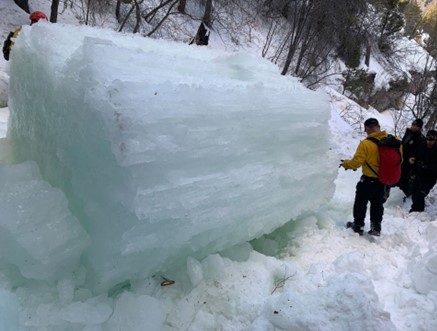An ice climbing accident in Utah on April 2nd took the life of Meg O’Neill, a vibrant member of the local climbing community. O’Neill died when the pillar that she and her two partners were climbing broke. O’Neill pushed her climbing partner out of harm’s way but was unfortunately struck by the giant pillar herself. The lead climber was seriously injured but survived the fall and trekked back out towards the trail entrance to call for rescue. O’Neill was killed instantly, however, her climbing partner who required helicopter evacuation is expected to make a full recovery.

Dislodged block of ice. Photo from Duchesne County Sheriff’s Office
Ice climbing is a sport that is gaining popularity in the United States. One can see why: climbers that ascend long spires and tiered waterfalls with ice tools and crampons are greeted by spectacular views of the terrain beneath them. Made even more popular by recent films including “The Alpinist” and “Reel Rock: Black Ice”, more and more climbers are venturing out into the winter landscape in search of icy adventures. There are now 16 ice climbing festivals in North America, making the sport even more accessible.
Unfortunately, as with all climbing disciplines, there are risks. Ice climbing and mountaineering inherently have higher risk, now possibly made worse by conditions sensitive to climate change and more novice ice climbers on routes. One study from the 2019 Ouray Ice Festival recorded 17.6 injuries per 1000 participation hours. In comparison, a prospective cohort study found an injury rate of 9.8 injuries per 1000 participation hours in a survey of ice climbers.
Ice climbing accidents may occur in remote canyons and require special resources for evacuation. As in this scenario, the uninjured climber had to travel back to the trailhead before being able to call for help, increasing the time from accident to pre-hospital care. With below-freezing temperatures often the norm, hypothermia is factor that must be considered as well.
One can be a dedicated student of any climbing discipline and still incur unpreventable risks from the environment. In this instance, there was no report of a technical error by the leader, belayer, or O’Neill. Locals have stated that this winter ice season lasted longer than usual, however, despite warmer than average temperatures there was no outward indication that the ice quality was diminished. Situational awareness is key and although it may not have saved the life of Meg O’Neill, it certainly helped her save her friend.